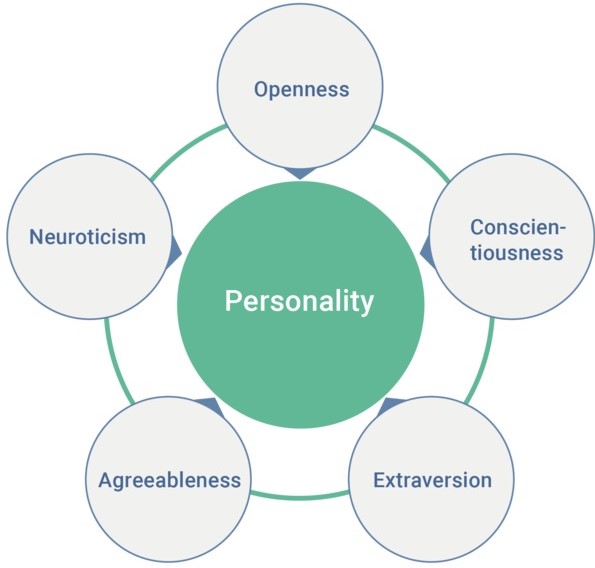The Big Five(OCEAN) Personality Traits
Qifan Wang (Talk | contribs) (→What is the big five(OCEAN)) |
Qifan Wang (Talk | contribs) (→What is the big five(OCEAN)) |
||
| Line 8: | Line 8: | ||
== The Big Idea == | == The Big Idea == | ||
=== What is ''the big five(OCEAN)'' === | === What is ''the big five(OCEAN)'' === | ||
| − | The big five(OCEAN) theory has developed, widespread, and ascended to the dominant status of the personality researching field in the last 20 years. [4] Apparently, OCEAN, the capital five letters, come from five basically general-accepted perspectives of personality traits are '''O'''penness, '''C'''onscientiousness, '''E'''xtraversion, '''A'''greeableness, and '''N'''euroticism. | + | The big five(OCEAN) theory has developed, widespread, and ascended to the dominant status of the personality researching field in the last 20 years. [4] Apparently, OCEAN, the capital five letters, come from five basically general-accepted perspectives of personality traits are '''O'''penness, '''C'''onscientiousness, '''E'''xtraversion, '''A'''greeableness, and '''N'''euroticism.[[File:Personality traits.jpg]] |
== Application == | == Application == | ||
Revision as of 20:53, 19 February 2022
Contents |
Abstract
Projects are done by people and for people.[1] Good project management is about how to organize people efficiently involving positions and tasks assigning, ways of communication, meeting people's satisfaction, etc.
Personality traits play an important role in people management, which have a big influence on success, efficiency, satisfaction, risk attitudes, performance, and more of projects. Since in a project, people have different backgrounds, interests, and personalities that make people think and manage the tasks in a different way and increase risks of conflicts somehow. A good perception of employees’ personality traits is a key for project managers to organize and design their teams. The similar and complementary personality traits make people, from different backgrounds and interests, well connected in a project and highly affect how and what they do in a project. Similarly, the action and decisions that project managers made are impacted by personality traits, which are not related to the technical part. It also influences how project managers deal with the relationship of different stakeholders.[1]
The so-called big five (OCEAN) personality traits theory is considered the dominant approach for representing the human trait structure today. Researchers have used the theory to predict individual differences in numerous settings: clinical (reviewed in Costa, 1991), industrial and organizational (e.g., Barrick & Mount, 1991, 1996; Barry & Stewart, 1997; Mount & Barrick, 1995), counseling (McCrae & Costa, 1991), and more [2].It was founded by Fiske (1949) and later expanded and elaborated by Norman (1967), Smith (1967), Goldberg (1981), and McCrae and Costa (1987). This theory contains five basic factors that are Openness, Conscientiousness, Extraversion, Agreeableness, Neuroticism[3].
The Big Idea
What is the big five(OCEAN)
The big five(OCEAN) theory has developed, widespread, and ascended to the dominant status of the personality researching field in the last 20 years. [4] Apparently, OCEAN, the capital five letters, come from five basically general-accepted perspectives of personality traits are Openness, Conscientiousness, Extraversion, Agreeableness, and Neuroticism.
Application
Limitations
Annotated bibliography
- ↑ 1.0 1.1 Geraldi, Joana et al. How to DO Projects : A Nordic Flavour to Managing Projects. Dansk Standard, 2017, pp. 160 s.
- ↑ Roccas, Sonia, et al. “The Big Five Personality Factors and Personal Values.” Personality and Social Psychology Bulletin, vol. 28, no. 6, Sage Publications, 2002, pp. 789–801, doi:10.1177/0146167202289008.
- ↑ Lee, Chia Kuang, and Mei Yit Foo. “Risk Attitudes and the Big Five Personality Traits: a Study on Construction Project Practitioners in Malaysia.” International Journal of Construction Management, Taylor and Francis Ltd., 2020, pp. 1–11, doi:10.1080/15623599.2020.1793506.